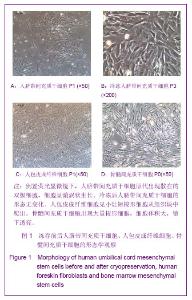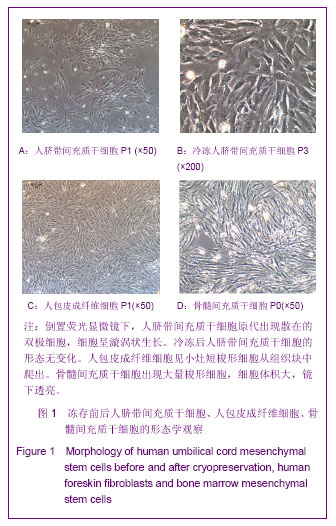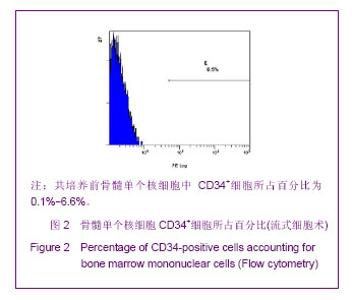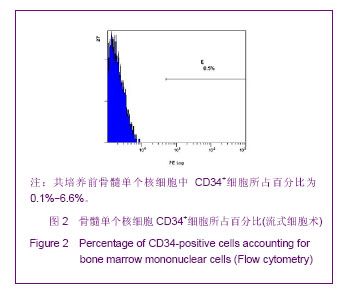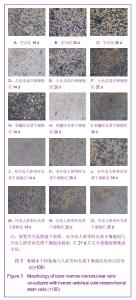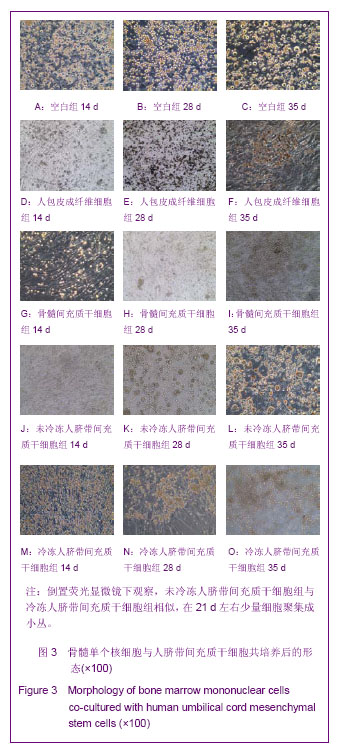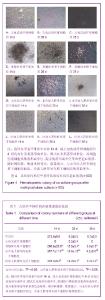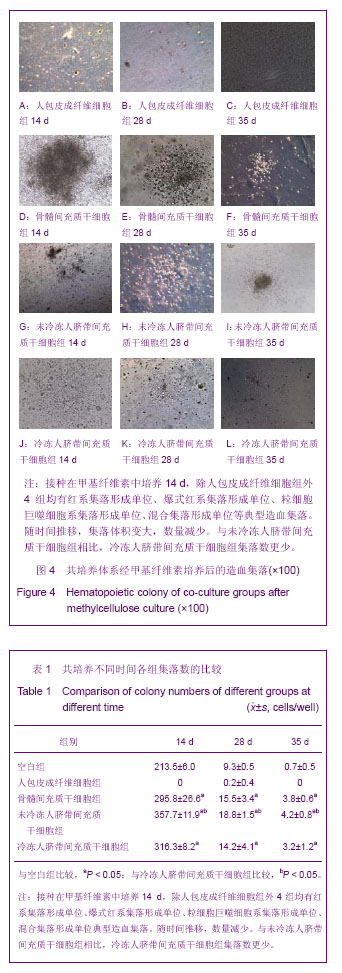| [1] Romanov YA, Svintsitskaya VA, Smirnov VN. Searching for alternative sources of postnatal human mesenchymal stem cells:candidate MSC-like cells from umbilical cord. Stem Cells. 2003;21(1):105-110.[2] Nishida S, Endo N, Yamagiwa H, et al. Number of osteoprogenitor cells in human bone marrow markedly decreases after skeletal maturation. J Bone Miner Metab. 1999;17(3):171-177.[3] Robinson SN, Ng J, Niu T, et al. Superior ex vivo cord blood expansion following co-culture with bone marrow-derived mesenchymal stem cells. Bone Marrow Transp lant. 2006; 37(4):359-366.[4] Zhang Y, Chai C, Jiang XS, et al. Co-culture of umbilical cord blood CD34+cells with human mesenchymal stem cells. Tissue Eng. 2006;12(8):2161-2170.[5] 杨平地,黄友章,沈建良,等.脐带血清对造血细胞的增殖刺激作用[J].中国免疫学杂志,2002,18(12):844-846.[6] De Lima M, McNiece I, Robinson SN, et al. Cord-blood engraftment with ex vivo mesenchymal-cell co-culture. N Engl J Med. 2012;367(24):2305-2315.[7] Noort WA, Kruisselbrink AB, In’t Anker PS, et al. Mesenchymal stem cells promote engraftment of human umbilical cord blood-derived CD34(+) cells in NOD/SCID mice. Exp Hematol. 2002;30(8):870-878.[8] Isern J, Martín-Antonio B, Ghazanfari R. Self-renewing human bone marrow mesenspheres promote hematopoietic stem cell expansion. Cell Rep. 2013;3(5):1714-1724. [9] Zaker F, Nasiri N, Oodi A, et al. Evaluation of umbilical cord blood CD34 (+) hematopoietic stem cell expansion in co-culture with bone marrow mesenchymal stem cells in the presence of TEPA. Hematology. 2013;18(1):39-45. [10] Rodríguez-Pardo VM, Vernot JP. Mesenchymal stem cells promote a primitive phenotype CD34+c-kit+ in human cord blood-derived hematopoietic stem cells during ex vivo expansion. Cell Mol Biol Lett. 2013;18(1):11-33.[11] Weiss ML, Anderson C, Medicetty S, et al. Immune properties of human umbilical cord Wharton’s jelly-derived cells. Stem Cells. 2008;26(11):2865-2874.[12] Luan X, Li G, Wang G, et al. Human placenta-derived mesenchymal stem cells suppress T cell proliferation and support the culture expansion of cord blood CD34? cells: a comparison with human bone marrow-derived mesenchymal stem cells. Tissue Cell. 2013;45(1):32-38.[13] Mitchell KE, Weiss ML, Mitchell BA, et al. Matrix cells from Wharton’s Jelly form neurons and glia. Stem Cells. 2003;21(1): 50-60.[14] Hu J, Wang F, Sun R, et al. Effect of combined therapy of human Wharton's jelly-derived mesenchymal stem cells from umbilical cord with sitagliptin in type 2 diabetic rats. Endocrine. in press. [15] Messerli M, Wagner A, Sager R, et al. Stem Cells From Umbilical Cord Wharton's Jelly From Preterm Birth Have Neuroglial Differentiation Potential. Reprod Sci. in press. [16] Wu S, Ju GQ, Du T et al. Microvesicles Derived from Human Umbilical Cord Wharton's Jelly Mesenchymal Stem Cells Attenuate Bladder Tumor Cell Growth In Vitro and In Vivo. PLoS One. 2013;8(4):e61366. [17] Baba K, Yamazaki Y, Ishiguro M. Osteogenic potential of human umbilical cord-derived mesenchymal stromal cells cultured with umbilical cord blood-derived fibrin: A preliminary study. J Craniomaxillofac Surg. in press. [18] Anzalone R, Lo Iacono M, Corrao S, et al. New emerging potentials for human Wharton's jelly mesenchymal stem cells: immunological features and hepatocyte-like differentiative capacity. Stem Cells Dev. 2010;19(4):423-438. [19] Fong CY, Subramanian A, Biswas A, et al. Derivation efficiency, cell proliferation, freeze-thaw survival, ‘stemness’ properties, and differentiation of human Wharton’s jelly stem cells: their potential for concurrent banking with cord blood for regenerative medicine purposes. Reprod Biomed Online. 2010; 21(3):391-401.[20] Rahul S, David L, Dolores B, et al. Human Umbilical Cord Perivascular (HUCPV) Cells: A Source of Mesenchymal Progenitors. Stem Cells. 2005;23(2):220-229.[21] Beshlawy AE, Metwally HG, Khalek KA, et al.The effect of cryopreservation on the recovery and expansion of umbilical cord blood hematopoietic stem cells. Exp Clin Transplant. 2009;7(1):50-55.[22] Ma Y, Zhang DQ, Chen L, et al. Super paramagnetic iron oxide nanoparticles lable human bone marrow and umbilical cord mesenchymal stem cells. Zhongguo Zuzhi Gongcheng Yanjiu. 2012;16(45):8398-8405.[23] Liu Z, Zhu W, Yu Y, et al. Derivation and long term culture of human parthenogenetic embryonic stem cells using human foreskin feeders. J Assist Reprod Genet. 2010;27(6):285- 291.[24] Majumdar MK, Thiede MA, Haynesworth SE, et al. Human marrow-derived mesenchymal stem cells(MSCs)exp ress hematopoietic cytokines and support long-term hematopoiesis when differentiated toward stromal and osteogenic lineages. J Hematother Stem Cell Res. 2000; 9(6):841-848.[25] Christodoulou I, Kolisis FN, Papaevangeliou D. Comparative Evaluation of Human Mesenchymal Stem Cells of Fetal (Wharton's Jelly) and Adult (Adipose Tissue) Origin during Prolonged In Vitro Expansion: Considerations for Cytotherapy. Stem Cells Int. 2013;2013:246134.[26] Anzalone R, Lo Iacono M, Loria T, et al. Wharton’s jelly mesenchymal stem cells as candidates for beta cells regeneration: extending the differentiative and immunomodulatory benefits of adult mesenchymal stem cells for the treatment of type 1 diabetes. Stem Cell Reviews and Reports. 2011;7(2):342-363.[27] Rocca GL, Anzalone R, Corrao S. et al. Isolation and characterization of Oct-4+/HLA-G+ mesenchymal stem cells from human umbilical cord matrix: differentiation potential and detection of new markers. Histochem Cell Biol. 2009;131(2): 267-282.[28] Cao FJ, Feng SQ. Human umbilical cord mesenchymal stem cells and the treatment of spinal cord injury. Chin Med J (Engl). 2009;122(2):225-231. [29] Deans RJ, Moseley AB. Mesenchymal stem cells: biology and potential clinical uses. Exp Hematol. 2000;28(8):875-884.[30] Wang HS, Hung SC, Peng ST et al. Mesenchymal Stem Cells in the Wharton’s Jelly of the Human Umbilical Cord. Stem Cells. 2004;22(7):1330-1337. [31] Tsai MS, Lee JL, Chang YJ, et al. Isolation of human multipotent mesenchymal stem cells from second trimester amniotic fluid using a novel two-stage culture protocol. Human Reprod. 2004;19(6):1450-1456.[32] Karahuseyinoglu S, Cinar O, Kilic E, et al. Biology of stem cells in human umbilical cord stroma: in situ and in vitro surveys. Stem Cells. 2007;25(2):319-331. [33] 沈亚文,王小华,孙巍.造血干细胞移植中单个核计数与CD34~+细胞计数的比较[J].中国医学工程,2013,21(01):96.[34] Liu M, Yang SG, Liu PX, et al. Comparative study of in vitro hematopoietic supportive capability of human mesenchymal stem cells derived from bone marrow and umbilical cord. Zhongguo Shi Yan Xue Ye Xue Za Zhi. 2009;17(5): 1294-1300. |
